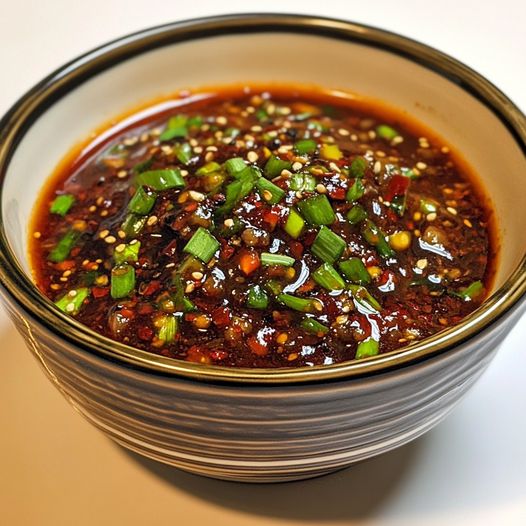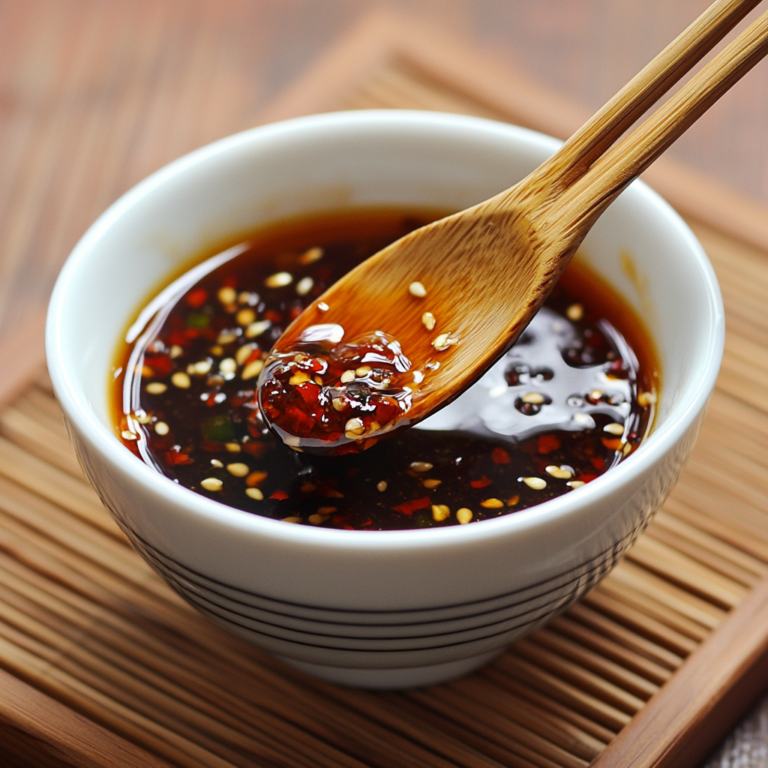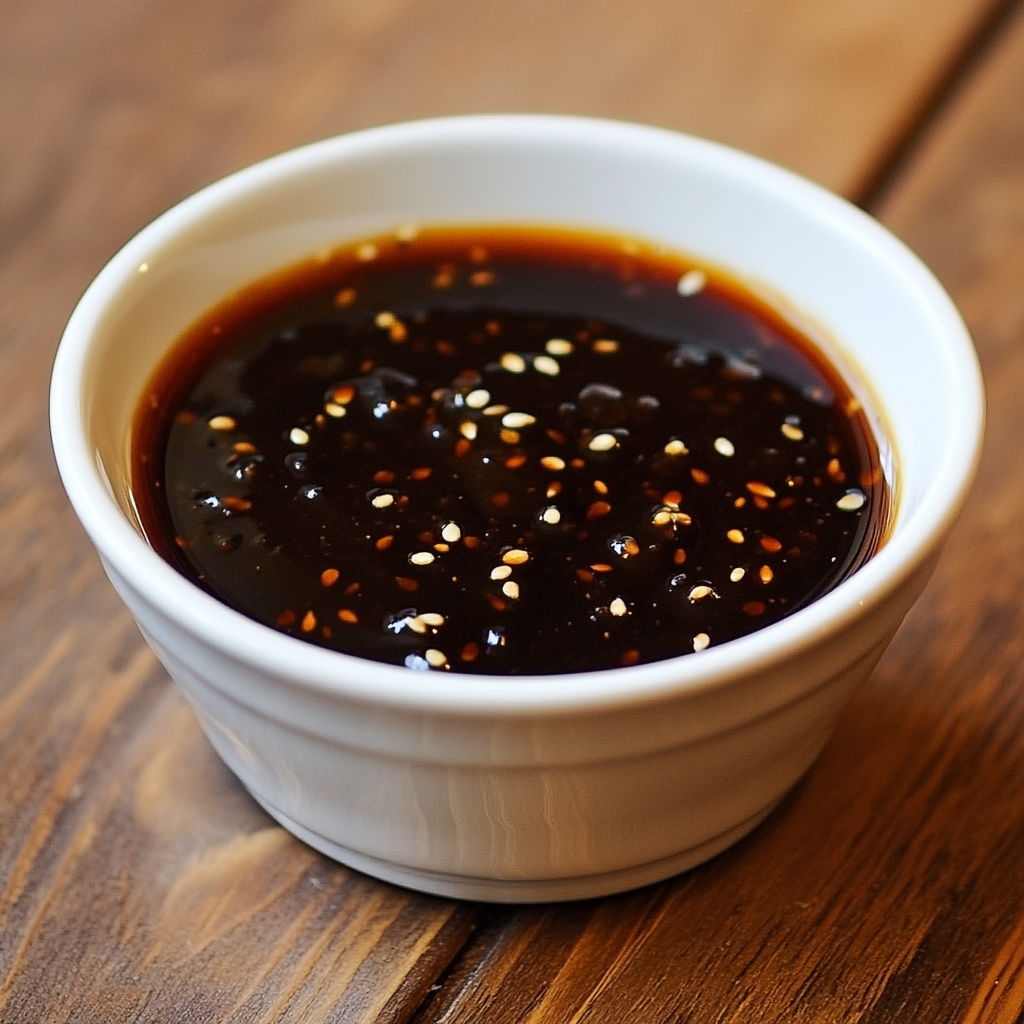Introduction to Spicy Szechuan Sauce

Spicy Szechuan Sauce is the ultimate bold and flavorful condiment that packs a punch with every bite. Known for its spicy, savory, and slightly numbing sensation, this sauce is a staple in Szechuan cuisine. Whether you’re making stir-fries, dipping dumplings, or drizzling it over noodles, this sauce will elevate your dishes to the next level.
Szechuan cuisine is rooted in bold, spicy flavors, with chili peppers and Szechuan peppercorns creating a unique combination of heat and numbing sensation. Spicy Szechuan sauce, once used in traditional dishes, has gained global fame as a staple for spice lovers. Its versatility now extends beyond Chinese cuisine, enhancing stir-fries, meats, seafood, and even vegan dishes. Whether used as a dipping sauce, marinade, or pizza topping, its rising popularity reflects the growing global love for spicy flavors and its ability to elevate a wide range of recipes.
Essential Ingredients for Spicy Szechuan Sauce
Spicy Szechuan sauce is renowned for its bold, complex flavors, which are achieved through a harmonious blend of key ingredients. Each component plays a critical role in defining the sauce’s distinctive profile, thus enhancing the overall culinary experience.
One of the cornerstone ingredients is chili paste, which provides the prominent heat characteristic of Szechuan cuisine. This paste is typically made from a variety of red chilies, contributing both spice and depth to the sauce. A common choice is doubanjiang, a fermented broad bean and chili paste that adds a unique umami flavor.
Soy sauce is another essential ingredient, offering a salty, savory element that balances the spiciness. There are different varieties of soy sauce, and opting for a dark soy sauce may enhance the sauce’s color while providing a richer flavor. Additionally, the use of sesame oil adds a nutty aroma and richness, rounding out the flavor profile of the sauce.
Garlic and ginger are indispensable for their aromatic qualities. Garlic imparts a pungent warmth, while ginger adds a subtle spiciness and brightness, making them vital for achieving a well-rounded sauce. The combination of these aromatics ensures a multi-dimensional flavor that elevates the dish it accompanies.
Another key component is rice vinegar, which adds a subtle acidity that balances the sauce’s richness. Additionally, ingredients like green onions or peanuts offer textural contrast and deepen the flavor, making the sauce both spicy and complex.
In summary, the core ingredients—chili paste, soy sauce, garlic, ginger, sesame oil, and vinegar—harmonize to create the signature flavor of spicy Szechuan sauce. Each element contributes its distinct quality, resulting in a rich, irresistible sauce that excites the palate.
Steps to Cook Spicy Szechuan Sauce
To prepare Spicy Szechuan Sauce at home, start by gathering all the necessary ingredients. This includes garlic, ginger, Szechuan peppercorns, chili oil, soy sauce, rice vinegar, and various other spices such as brown sugar and sesame oil. Having everything on hand will streamline the cooking process and ensure that you don’t miss any crucial components.
Begin by finely chopping or mincing the garlic and ginger. This will release their flavors effectively when cooked. For a more intense taste, consider lightly toasting the Szechuan peppercorns in a dry skillet over medium heat for a few minutes. This step enhances their aromatic profile and deepens the overall flavor of the sauce.
In a saucepan, combine the garlic, ginger, and toasted peppercorns with a generous amount of chili oil. Allow this mixture to sauté over medium heat for about 2 to 3 minutes, stirring continuously to prevent burning. Once fragrant, it is time to incorporate the soy sauce and rice vinegar, which contribute a balance of savoriness and acidity to the sauce.
Next,
add in the brown sugar to provide a hint of sweetness that complements the heat of the chili oil. Stir well to ensure that the sugar dissolves entirely. After incorporating all the ingredients, let the mixture simmer gently for approximately 10 minutes. This simmering process is vital as it allows the flavors to meld together and the sauce to thicken slightly.
Once you reach the desired consistency, blend the sauce using an immersion blender or transfer it to a standard blender, depending on how smooth you want the final product. Taste the sauce and make any necessary adjustments, such as adding more chili oil for extra heat or soy sauce for additional saltiness.
Once satisfied, let the sauce cool before transferring it to a storage container. Your homemade Spicy Szechuan Sauce is now ready to enhance a variety of dishes.
Tips for Making the Perfect Szechuan Sauce
Creating an exceptional Szechuan sauce involves a careful balance of flavors and the right techniques to ensure optimal taste and texture. One of the first tips to consider is adjusting the spice levels according to your personal preference. Traditional Szechuan sauce features a prominent heat profile directly linked to the quantity of Sichuan peppercorns and dried chilies used. If you are sensitive to spiciness, start with a smaller amount and gradually increase until you find your desired heat threshold.
Balancing flavors is crucial for achieving depth in your Szechuan sauce. The foundation usually consists of soy sauce, vinegar, and sugar; therefore, it is essential to taste as you cook. If the sauce seems too salty, consider adding more sugar or vinegar to counterbalance. Conversely, if it lacks depth, incorporating garlic or ginger can enhance the overall flavor profile significantly. Remember that achieving the right acidity with vinegar can brighten the sauce, making it more vibrant.
The thickness of the sauce can also be customized. If you prefer a thicker consistency, consider adding a cornstarch slurry toward the end of the cooking process. For a thinner sauce, simply add a bit more liquid, such as water or broth, while ensuring the flavor remains concentrated. Common mistakes to avoid include skipping the toasting of spices, which diminishes the sauce’s aromatic qualities, and not allowing the sauce to simmer long enough for the flavors to meld.
By following these tips, you can refine your Szechuan sauce-making technique to suit your taste while achieving a mouthwatering result that truly showcases the essence of this beloved cuisine.
How to Store Szechuan Sauce
Proper storage of Szechuan sauce is essential to maintain its vibrant flavors and ensure its longevity. After preparation, it is advisable to allow the sauce to cool completely before transferring it to storage containers. Glass jars or airtight plastic containers are preferable for storing Szechuan sauce, as they help preserve the flavor and prevent contamination.
When stored in the refrigerator, homemade Szechuan sauce can last for about one to two weeks. Ensure that the container is sealed tightly, as exposure to air can lead to oxidation, affecting taste and safety. If you find that you have made an excess quantity, freezing is an excellent alternative for longer preservation. By placing the sauce in freezer-safe containers or ice cube trays, you can conveniently store it for up to six months. If using ice cube trays, once frozen, transfer the cubes to a freezer bag for more efficient storage.
It is also important to be aware of the signs that Szechuan sauce has gone bad. Look for changes in color, texture, or smell. A sour or off-smelling aroma usually indicates spoilage. Additionally, if you notice any mold or separation in the sauce, it is best to discard it to avoid any foodborne illnesses. Regularly checking the sauce for these signs will not only protect your health but also ensure your culinary endeavors do not go to waste.
For optimal freshness, it is recommended to always use clean utensils when scooping out the sauce. This practice helps prevent bacterial contamination, ultimately extending the shelf life of your Szechuan sauce. By following these storage guidelines, you can enjoy the distinctive taste of Szechuan cuisine at your convenience.
Exploring Variations of Szechuan Sauce
Szechuan sauce, known for its bold heat and flavor, offers many variations to accommodate different tastes and dietary needs. One common modification is to reduce the spice level for a milder version by decreasing Sichuan peppercorns or substituting sweeter ingredients while maintaining its rich umami essence.
For those following a vegan diet, the sauce can be adapted by replacing animal-based ingredients like oyster sauce with plant-based alternatives such as mushroom or soy sauce, ensuring a satisfying flavor.
Creative variations can also elevate the sauce, like adding peanut butter for a creamy texture or honey for a sweet contrast to the heat. These adaptations enhance the sauce’s versatility, allowing it to pair well with a wider range of dishes.
Ultimately, these variations showcase the adaptability of Szechuan sauce, catering to different preferences and encouraging culinary creativity while highlighting the enduring appeal of Szechuan cuisine.
Dishes to Use Szechuan Sauce With
Szechuan sauce is not only known for its heat but also for its remarkable versatility in culinary applications. This spicy condiment can elevate a variety of dishes, making it a favored choice among culinary enthusiasts. One of the most common uses of Szechuan sauce is with stir-fries. The robust flavors of the sauce complement vegetables and proteins such as chicken, beef, or tofu, creating a dish that is both satisfying and packed with flavor. When preparing a stir-fry, adding Szechuan sauce towards the end of cooking ensures that its distinct characteristics are preserved.
Grilled meats also pair excellently with Szechuan sauce. The combination of smoky flavors from the grill with the sauce’s spiciness creates an aromatic experience. Chicken wings, pork ribs, or skewered shrimp brushed with this sauce can offer a delightful kick at barbecues and gatherings. Furthermore, seafood lovers can enjoy Szechuan sauce as a marinade for fish and shellfish. Grilled salmon or sautéed shrimp can be enhanced with the sauce, providing a unique flavor profile that excites the palate.
Noodle dishes present another opportunity to utilize Szechuan sauce. Whether it’s stir-fried noodles or a spicy Szechuan cold noodle salad, the sauce integrates well with various noodle types, providing depth and heat to each bite. For those who appreciate dipping sauces, Szechuan sauce can serve as an exceptional accompaniment to spring rolls, dumplings, or any fried starter, adding a zest of flavor to every meal. As seen, Szechuan sauce is not just a condiment; it’s a transformative element that enhances numerous dishes across various cuisines.
Health Benefits and Nutritional Information
Spicy foods have gained attention for their potential health benefits, largely attributed to the active compounds found in ingredients such as chili peppers, garlic, and ginger, which are often featured in Szechuan sauce. One of the primary compounds in chili peppers is capsaicin. This substance has been associated with an enhanced metabolism, potentially aiding in weight management and fat burning. Moreover, capsaicin may promote better circulation and cardiovascular health by helping to lower cholesterol levels.
Garlic, another key ingredient, possesses numerous health-promoting properties. It contains compounds like allicin, which have been shown to exhibit anti-inflammatory and antibacterial effects. Consuming garlic may contribute to immune system support and has been linked to reduced risk factors for heart disease. Additionally, garlic is known for its potential to lower blood pressure, making it a valuable addition to traditional recipes such as Szechuan sauce.
Ginger is similarly rich in beneficial components. It contains gingerol, a potent antioxidant, which may help in alleviating digestive issues and reducing inflammation throughout the body. The consumption of ginger has also been linked to better nausea management and improved metabolic health, underscoring its role as an essential ingredient in many spicy dishes, including Szechuan cuisine.
Beyond these individual ingredients, Szechuan sauce typically includes elements such as soy sauce, sesame oil, and vinegar. These ingredients contribute not only to the flavor profile but also provide additional nutritional value. Soy sauce delivers protein and certain vitamins; sesame oil is a source of healthy fats, while vinegar can aid digestion and support blood sugar levels. Together, these components create a sauce that not only enhances culinary experiences but also offers a variety of health benefits when consumed in moderation.
Conclusion and Final Thoughts on Spicy Szechuan Sauce
In summary, Spicy Szechuan Sauce captures the essence of Szechuan cuisine with its bold blend of spicy, numbing, and savory flavors. This versatile condiment enhances a variety of dishes, and the recipe provided offers an easy way to make it at home, allowing for customization of spice levels to suit personal tastes. A must-try for anyone looking to elevate their culinary creations.
The appeal of Szechuan sauce lies not only in its bold flavors but also in its versatility. This sauce can enhance a wide range of dishes, from stir-fries and grilled meats to marinades and dipping sauces.Its versatility allows for use in both traditional dishes and modern recipes, offering endless creative possibilities in the kitchen. Whether you’re a seasoned chef or a beginner, mastering Szechuan sauce can enhance your culinary skills.
For those eager to explore this exciting sauce, starting with the basic recipe and gradually adjusting it to personal preferences is key. Experimenting with spice levels, additional ingredients, or unique pairings can lead to delightful culinary discoveries. The journey of creating Spicy Szechuan Sauce is rewarding and a fantastic way to savor the rich flavors of Szechuan cooking at home.
Embracing the boldness of Spicy Szechuan Sauce can invigorate your dishes and impress your guests. So, gather your ingredients, embrace your creativity, and dive into the world of Szechuan flavors. Happy cooking!
Print
The Ultimate Guide to Spicy Szechuan Sauce: Ingredients, Cooking Steps, Tips, and Variations
Discover how to make Spicy Szechuan Sauce, a bold and fiery condiment that adds a punch of flavor to stir-fries, noodles, and more. Perfect for lovers of spicy food!
- Total Time: 17
Ingredients
- 1/4 cup soy sauce
- 2 tablespoons rice vinegar
- 1 tablespoon chili oil
- 1 tablespoon Szechuan peppercorns
- 1 tablespoon garlic, minced
- 1 tablespoon ginger, minced
- 1 tablespoon sugar
- 2 teaspoons cornstarch (optional, for thickening)
- 1/4 cup water
Instructions
- Prepare the Base: In a small saucepan, heat chili oil over medium heat. Add minced garlic and ginger, and sauté for 1-2 minutes until fragrant.
- Add Spices: Add the Szechuan peppercorns and stir-fry for another minute. Be careful not to burn the spices.
- Make the Sauce: Pour in soy sauce, rice vinegar, sugar, and water. Bring to a simmer, stirring occasionally. If you prefer a thicker sauce, dissolve cornstarch in a tablespoon of water and stir it into the sauce.
- Cook: Allow the sauce to cook for 5-7 minutes until slightly thickened.
- Cool and Store: Remove from heat and let it cool. Store in an airtight jar in the refrigerator for up to a week.
Notes
How to Use Spicy Szechuan Sauce:
- Stir-Fries: Toss in your favorite veggies, tofu, or meat for a fiery stir-fry.
- Dipping Sauce: Perfect for dumplings, spring rolls, and egg rolls.
- Noodles: Drizzle over ramen or lo mein for a spicy twist.
Variations:
- Sweeter Version: Add a tablespoon of honey for a sweet-spicy flavor.
- Extra Spicy: Mix in extra chili oil or fresh chopped chilies for a hotter kick.
- Prep Time: 5
- Cook Time: 12
Keywords: Spicy Szechuan Sauce, Szechuan sauce recipe, Homemade Szechuan sauce, Spicy Asian sauce, Chinese spicy sauce, Easy Szechuan sauce, Szechuan chili sauce, Stir-fry sauce recipe, Szechuan peppercorn sauce, Sichuan sauce recipe, Bold Asian flavors, Fiery Szechuan sauce.

